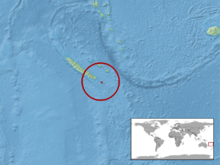Terror skink
| Terror skink | |
|---|---|
| Conservation status | |
| Scientific classification | |
| Kingdom: | Animalia |
| Phylum: | Chordata |
| Subphylum: | Vertebrata |
| Class: | Reptilia |
| Order: | Squamata |
| Suborder: | Sauria |
| Infraorder: | Scincomorpha |
| Family: | Scincidae |
| Subfamily: | Eugongylinae |
| Genus: | Phoboscincus |
| Species: | P. bocourti |
| Binomial name | |
| Phoboscincus bocourti (Brocchi, 1876) | |
 | |
| Synonyms | |
The terror skink (Phoboscincus bocourti) is a species of skink endemic to the Île des Pins (Isle of Pines) in New Caledonia.[2]
Etymology
The specific name, bocourti, is in honor of French zoologist Marie Firmin Bocourt.[3]
Rediscovery
This rare species was considered extinct until December 2003 when a specimen was found by some specialists from the French Muséum national d'histoire naturelle (the animal was photographed and filmed before being released). Before, it was only known from a single specimen, collected on the same island by a man named Balanza.
Diet
The teeth of P. bocourti are long, curved and sharp, suggesting predatory habits unusual for a large skink; most skinks are omnivorous. Its diet might include larger invertebrates, other lizards, young birds, and eggs.
Description
It is about 50 centimetres (20 in) long, making it the third largest reptilian predator on the island, the others being a prehistorically extinct land-going crocodile and goanna.
Behavior
It is probably nocturnal.
Threats
It may face predation and competition from cats, or the black, brown and Pacific rats that live on some parts of the island.
References
- ↑ Sadlier RA, Whitaker AH, Bauer AM. (2009). "Phoboscincus bocourti". IUCN Red List of Threatened Species. Version 2011.1. International Union for Conservation of Nature. Retrieved 6 August 2011.
- ↑ 2.0 2.1 Phoboscincus bocourti at ReptileDatabase.cz
- ↑ Beolens B, Watkins M, Grayson M. (2011). The Eponym Dictionary of Reptiles. Baltimore: Johns Hopkins University Press. xiii + 296 pp. ISBN 978-1-4214-0135-5. (Phoboscincus bocourti, pp. 28-29).
Further reading
- Brocchi [P]. 1876. "Sur un Scincoïdien nouveau appartenant au genre Eumèces". Bulletin de la Société philomathique de Paris, Series 6, 12: 95-97. (Eumeces bocourti, new species).
- Greer AE. 1974. "The genetic relationships of the Scincid lizard genus Leiolopisma and its relatives". Australian Journal of Zoology Supplementary Series 22 (31): 1-67. (Phoboscincus, new genus).
External links
- Description page, including photographs
- "Molecular phylogeny of the scincid lizards of New Caledonia and adjacent areas"
- IUCNRedlist.org
- Caut S, Holden M, Jowers MJ, Boistel R, Ineich I. (2013). "Is Bocourt’s Terrific Skink Really So Terrific? Trophic Myth and Reality." PLoS ONE 8 (10): e78638. doi:10.1371/journal.pone.0078638.
